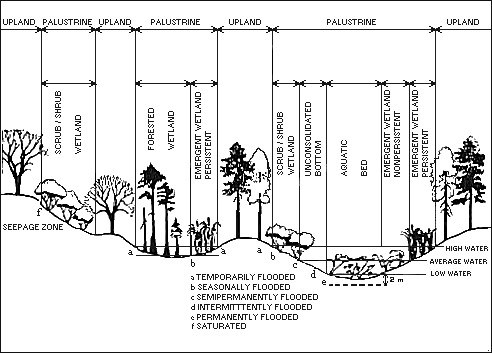
What Is An Emergent Wetland?Many different types of wetlands exist in middle Georgia, including swamps, marshes, bogs, wet meadows, bottomland hardwood forest, and stream overflow areas. Wetlands are covered by water some or all of the time depending on the seasonal rainfall. Non-tidal wetland ecosystems dominated by trees, shrubs, persistent emergents, and emergent mosses or lichens, are all grouped scientifically as a Palustrine System. Emergent wetlands are a transitional area between permanently wet and dry environments. It is place where the land “emerges” from the water to join the forest and the plants that grow there “emerge” from the water. They are specially adapted plants called hydrophytes (“water plants”) that grow well in a wetland environment. These plants thrive with their roots down in the water-saturated, oxygen-depleted soil and their tops in the air above the changing surface of the water.Why Are Wetlands So Important?Wetlands are important natural resources that provide numerous benefits to our society and contain many cultural resources that help us to understand the past. Wetlands provide vital habitats for many species of plants and animals that are threatened and endangered. Rare flora and fauna like these depend on a wetland environment to survive. In addition to supporting a rich diversity of wildlife, the wetlands provide society with both ecological and economic advantages. They provide water storage basins that reduce the amount of flooding and storm damage, minimize erosion of uplands, improve water quality by filtering pollutants, support healthy visitor use of public lands, and scientific research to help us understand these vital components of a healthy ecosystem. In the past, conversion of wetlands for economic uses as well as natural processes contributed to wetland destruction. Today federal, state and local governments and private organizations work together as partners to protect, preserve and create more wetland habitats. 
NPS How Are Wetlands Created?As Walnut Creek flows through a flat, forested bottomland, the small stream slows, leaves the rolling hills of the forested piedmont, and joins the Ocmulgee River on its journey through the coastal floodplain to the ocean. This is an area of environmental change called an ecotone. In 1994 an early summer hurricane moved piles of logs and mud that blocked Walnut Creek and created dams where this small stream from the piedmont enters the secondary floodplain of the Ocmulgee River. Beavers moved into the large newly created wetlands. Beavers are excellent hydrologic engineers and maintain their dams with a spillway designed to withstand minor floods. This new mosaic of aquatic, emergent, and forested wetlands attracted many new species of birds and animals. Ducks, fish, turtles, river otters and beavers moved into the area. Many wading birds, such as the great blue heron, egret, and anhinga (a relative of the cormorant) are now year-round residents of Ocmulgee Mounds National Historical Park’s wetlands environment; and can be seen from the boardwalk on the River Trail. The dead, standing hardwood snags provide habitat for many insects and the red-headed and pileated woodpeckers that like to eat them. An abundance of snakes and amphibians such as frogs and salamanders can be found in the revitalized wetlands.Understanding WetlandsEcosystems change over time in repeating successions of wet and dry environments. This newly flooded area has changed what we knew as a hardwood forest into a wetlands swamp, but it is only a cycle of changes in nature. As the large dead hardwood logs fall into the swamp, they provide places to trap and build up the soil level. During the next 100 years or more, this area will slow down the flood waters of the Walnut Creek, trapping soil and filtering pollutants from the water. Under the placid waters of the swamp the soil will be renewed. Eventually, another dramatic flood will carve a new channel for Walnut Creek and the area will drain faster. The plants and large trees of a hardwood forest will return to grow. The cycles of life we call nature will change once again from swamp to forest. Walking on the Opelofa Trail and the boardwalk of the River Trail, you experience the dramatic change from forested piedmont to swampy coastal floodplain. The rugged and starkly wet environment challenges your perceptions and feels wild and untamed. The successional changes of local environments often happen slowly, in this case severe weather was the key that moved the buildup of logs from the upland forest of the piedmont to this bottomland at the mouth of a creek, facilitating this exciting opportunity for you to observe the birth of the robust environment we call an emergent wetland. As we learn more about wetlands, we recognize the connections of all ecosystems within the biosphere, and our responsibility as stewards to care for these precious resources. At Ocmulgee Mounds National Historical Park, history and nature work together to remind us that ALL THINGS ARE CONNECTED. |
Last updated: November 29, 2020
